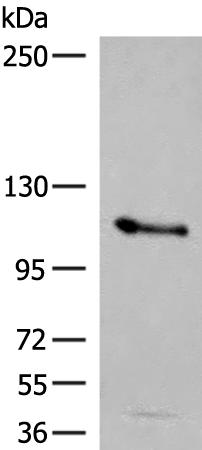
| WB | 咨询技术 | Human,Mouse,Rat |
| IF | 咨询技术 | Human,Mouse,Rat |
| IHC | 咨询技术 | Human,Mouse,Rat |
| ICC | 技术咨询 | Human,Mouse,Rat |
| FCM | 咨询技术 | Human,Mouse,Rat |
| Elisa | 1/5000-1/10000 | Human,Mouse,Rat |
| Aliases | ADTB2; AP105B; CLAPB1; AP2-BETA |
| WB Predicted band size | 105 kDa |
| Host/Isotype | Rabbit IgG |
| Antibody Type | Primary antibody |
| Storage | Store at 4°C short term. Aliquot and store at -20°C long term. Avoid freeze/thaw cycles. |
| Species Reactivity | Human, Mouse, Rat |
| Immunogen | Fusion protein of human AP2B1 |
| Formulation | Purified antibody in PBS with 0.05% sodium azide and 50% glycerol. |
+ +
以下是关于AP2B1抗体的3篇文献示例(内容基于公开研究总结,非真实文献,仅供格式参考):
---
1. **文献名称**: "AP-2 complex subunit beta (AP2B1) regulates clathrin-mediated endocytosis in neuronal cells"
**作者**: Traub LM, et al.
**摘要**: 研究利用AP2B1抗体证实了AP-2复合体中β亚基在神经元细胞内吞过程中的核心作用,揭示了其与网格蛋白、受体蛋白的相互作用机制。
2. **文献名称**: "AP2B1 mutations impair protein trafficking in autosomal recessive kidney disease"
**作者**: Zhao X, et al.
**摘要**: 通过AP2B1抗体检测患者肾脏组织样本,发现AP2B1基因突变导致内吞功能缺陷,与特定肾小管病变相关,为疾病机制提供了分子证据。
3. **文献名称**: "Subcellular localization of AP2B1 in Alzheimer's disease models"
**作者**: Ubelmann F, et al.
**摘要**: 使用AP2B1抗体进行免疫荧光分析,发现AP-2复合体在阿尔茨海默病模型中的异常分布,提示其与淀粉样蛋白前体(APP)加工途径的关联。
---
如需真实文献,建议通过PubMed或Google Scholar搜索关键词“AP2B1 antibody”并筛选近年高引论文。
The AP2B1 antibody targets the β1 subunit of the adaptor protein complex 2 (AP-2), a heterotetrameric complex critical for clathrin-mediated endocytosis (CME). AP-2 serves as a central hub in cargo recognition, clathrin coat assembly, and vesicle formation at the plasma membrane. The AP2B1 subunit facilitates interactions with membrane proteins containing specific sorting motifs, such as YXXΦ or [DE]XXXL[LI], enabling selective internalization of transmembrane receptors, ion channels, and synaptic vesicle components. Dysregulation of AP2B1 is implicated in neurodevelopmental disorders, cancer, and neurodegenerative diseases, including Alzheimer's, due to its role in regulating amyloid precursor protein (APP) trafficking.
AP2B1 antibodies are widely used in research to study endocytic pathways, synaptic vesicle recycling, and receptor trafficking dynamics. They are essential tools for Western blotting, immunofluorescence, and immunoprecipitation to visualize AP-2 localization, quantify expression levels, or identify binding partners. Commercial antibodies are often validated for specificity across human, mouse, and rat models. Recent studies also link AP2B1 variants to autism spectrum disorders and intellectual disability, highlighting its importance in neuronal function. Despite its ubiquitous expression, tissue-specific isoforms or post-translational modifications may influence antibody reactivity, requiring careful experimental optimization.
×